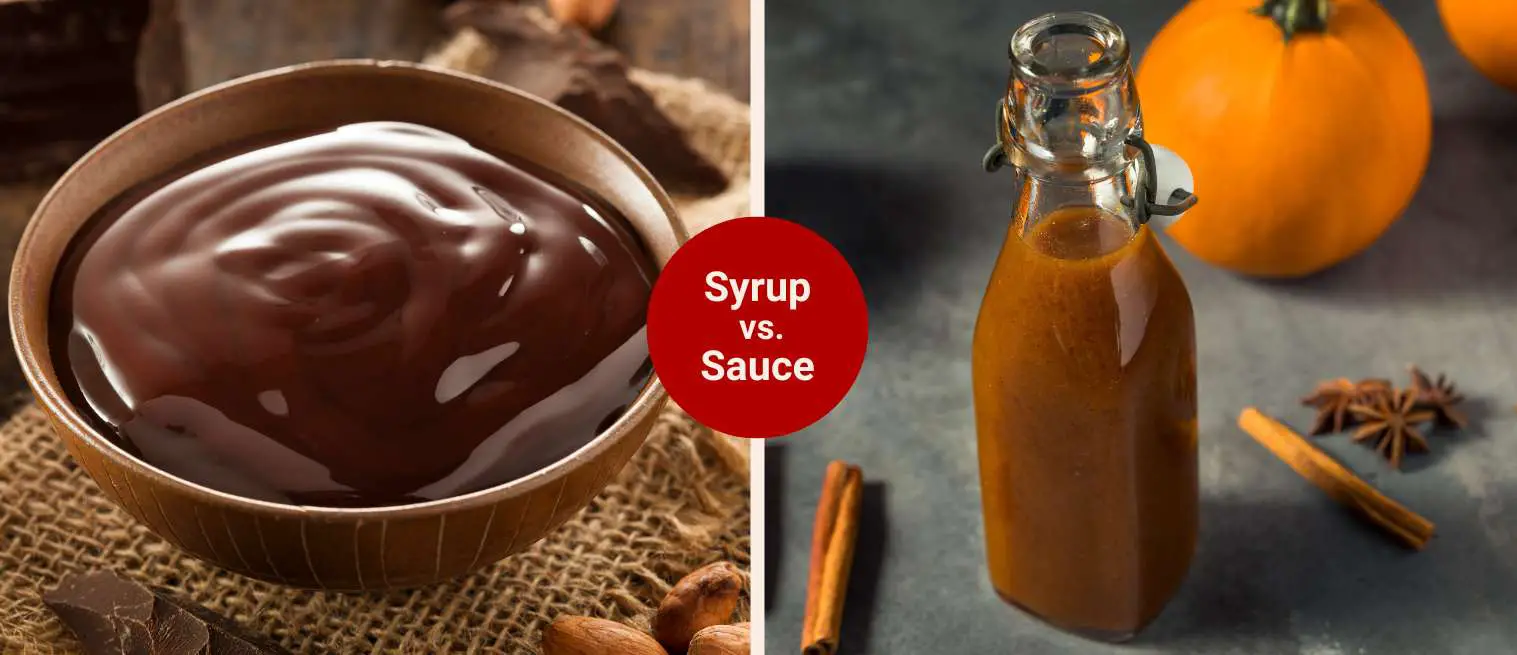Coffee Syrup vs. Sauce: What’s the Difference & How to Use Each
Last updated on August 14th, 2025 at 10:36 am
Ever wondered if you should be using syrup or sauce in your coffee? You’re not alone! These two flavoring agents often sit side-by-side in cafés and pantries, yet they serve very different purposes.
Syrups are smooth, sweet, and mix effortlessly into cold drinks. Sauces, on the other hand, are thicker, richer, and perfect for hot drinks or dessert drizzles.
In this post, we’ll explore the difference between coffee syrups and sauces, break down their textures, ingredients, and best uses—and help you figure out exactly which one to grab next time you’re crafting the perfect drink or dessert.
Coffee Syrup vs. Sauce: Core Differences
If you’ve ever wondered whether to reach for syrup or sauce when flavoring your coffee, it mostly comes down to texture, ingredients, and what kind of drink you’re making. So, here’s a quick breakdown:
| Category | Coffee Syrup | Coffee Sauce |
|---|---|---|
| Texture | Thin and liquid | Thick, dense, and creamy |
| Mixability | Easily dissolves in hot or cold drinks | Mixes best in hot drinks; may clump in cold ones |
| Ingredients | Simple blend of sugar and water (plus flavoring) | Often includes sugar, cream, butter, chocolate, or dairy |
| Flavor Strength | Lighter and sweeter flavor | Richer, bolder, and more intense |
| Application | Used for sweetening and flavoring throughout the drink | Used for topping, drizzling, or swirling for texture and richness |
| Best Uses | Iced coffee, cold brew, flavored lattes, milkshakes, tea | Mochas, cappuccinos, frappes, dessert drinks, whipped cream toppings |
| When to Choose | Best for cold drinks and subtle sweetness | Ideal for hot drinks and indulgent toppings |
| Use Together? | Yes! Layer vanilla syrup with mocha or caramel sauce for more complex flavor | Absolutely—combo flavors can take a drink from basic to barista-level delicious |
Notes: Whether you’re crafting something smooth and refreshing or warm, knowing the difference helps you make the right call every time. Anyway, if you want more details, keep reading.
What Is a Coffee Syrup?
Coffee syrup is basically your go-to liquid sweetener when you want to add flavor and sweetness without messing around with sugar crystals that won’t dissolve.
It’s thin, pourable, and usually made from just sugar and water, that is the base. Then you toss in your flavor of choice, whether it’s coffee itself or something more fun like vanilla or hazelnut. Also, it mixes easily into both hot and cold drinks.
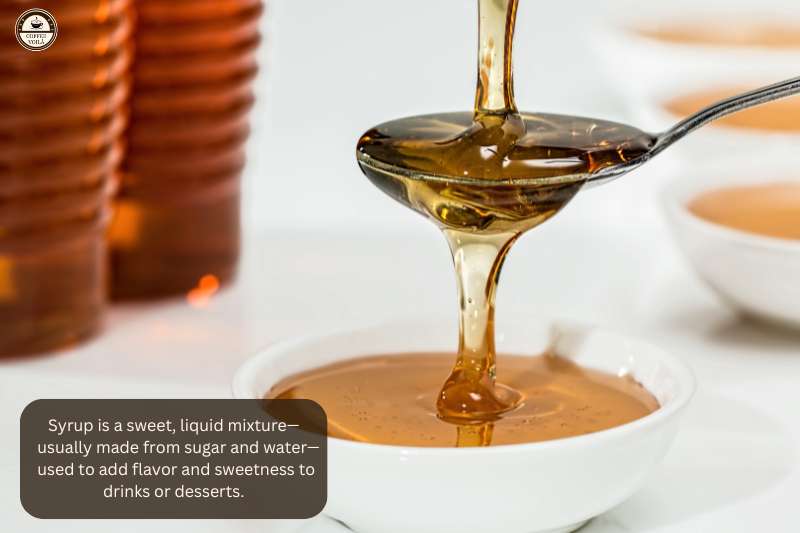
What Flavors You Commonly Have?
The most common coffee syrup flavors you’ll run into are vanilla, caramel, hazelnut, and mocha. Basically, all the usual suspects you’d find at a coffee shop menu. But there’s a lot more.
I’ve seen (and tried) flavors like toasted marshmallow, pumpkin spice, butter pecan, and even lavender. You can get wild with it, especially if you start making your own at home.
Where Is It Normally Used?
Coffee syrup is versatile. You’ll find it in lattes, cold brew, tea, milkshakes, and even cocktails. It’s awesome for homemade frappes too, way better than tossing sugar into the blender and hoping for the best.
You can even use it in baking. Just a tablespoon of vanilla syrup added to pancake batter or brushed over warm muffins adds a sweet little boost.
What Are Some Popular Brands?
Now, as I said, you can make coffee syrup at home. I walk you through exactly how to do it right here in this guide “Homemade Coffee Syrup Recipes“. But if you’re in a rush or want to try some ready-made options, you have some good options. For instance:
Torani is probably the most well-known. It’s what you’ll often see lined up at cafés, and their flavor selection is massive. You got everything from classic vanilla and hazelnut to toasted marshmallow and sugar-free options.
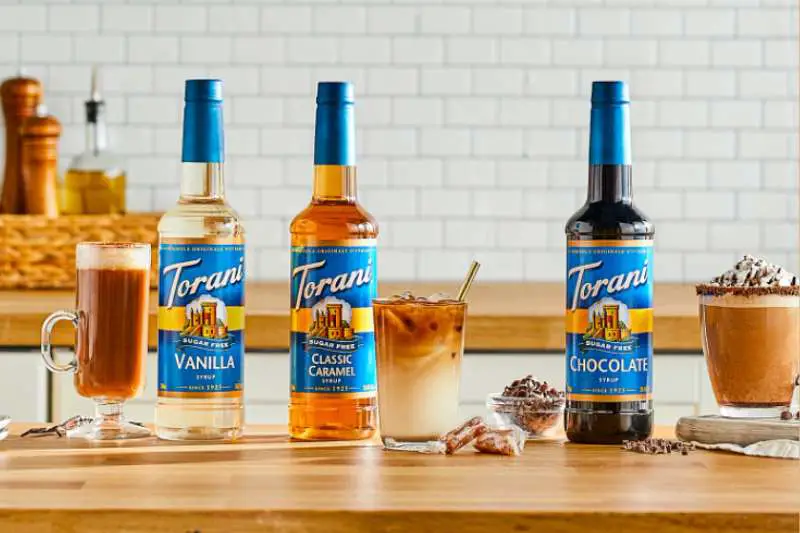
Monin is another big name, specifically if you’re looking for more gourmet or natural flavoring. Their syrups are often a bit more subtle, but the quality’s great. I’ve used their lavender and pistachio syrups in lattes and cocktails; they’re great.
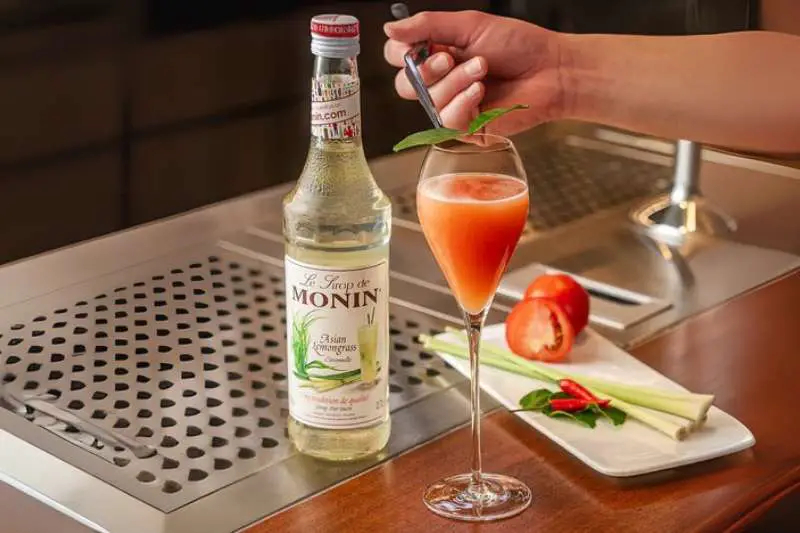
DaVinci Gourmet is commonly used in the foodservice world, and they’ve got a good variety of both classic and sugar-free syrups. I used their caramel syrup in a homemade frappuccino once and ended up finishing the whole bottle way too fast.
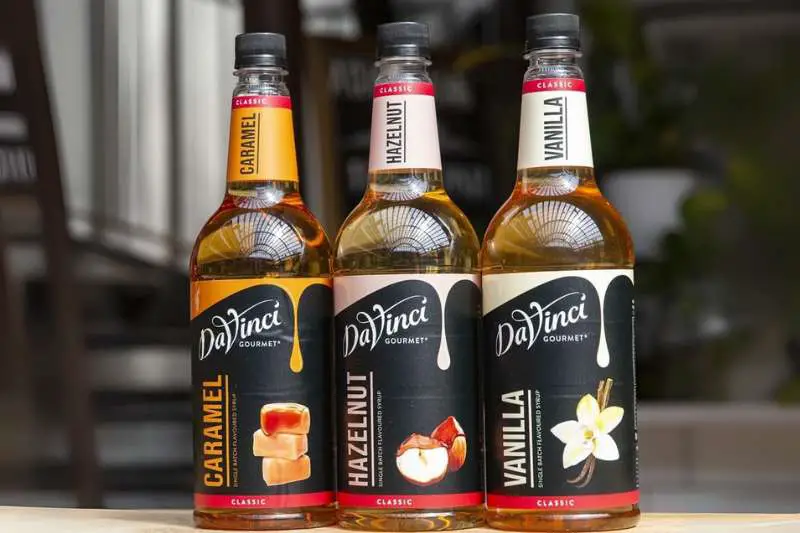
Jordan’s Skinny Syrups is a favorite for anyone watching sugar or carbs. Not everyone loves the stevia aftertaste. However, their fun flavors like birthday cake and coconut are hard to resist in iced coffee or blended drinks.
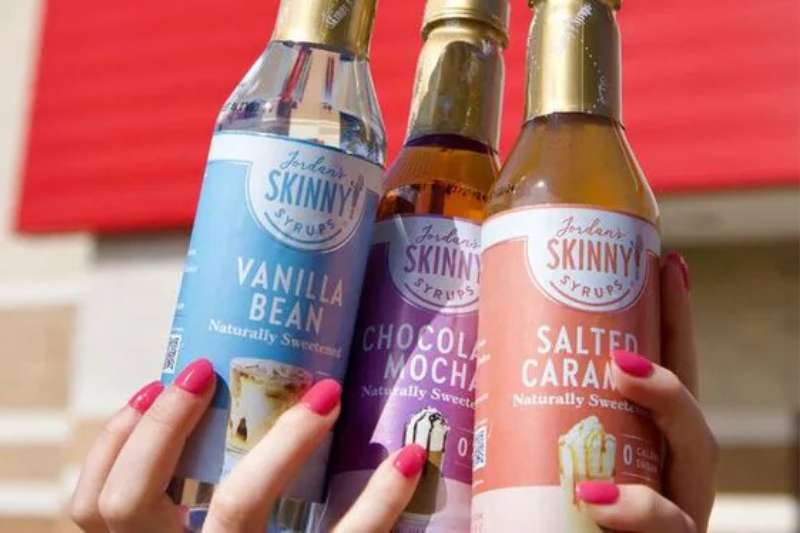
If you’re experimenting, try grabbing a couple sample-sized bottles before committing to a big one. Then once you find your flavor one, you can stock up.
What Is a Coffee Sauce?
Coffee sauce is the rich, creamy version of coffee syrup. It’s thick, almost like a dessert topping, and it’s usually made with ingredients like sugar, cream, butter, and sometimes chocolate.
The texture alone tells you this isn’t something you’d toss into an iced latte and call it a day. It will most likely clump into a goo at the bottom of the cup.
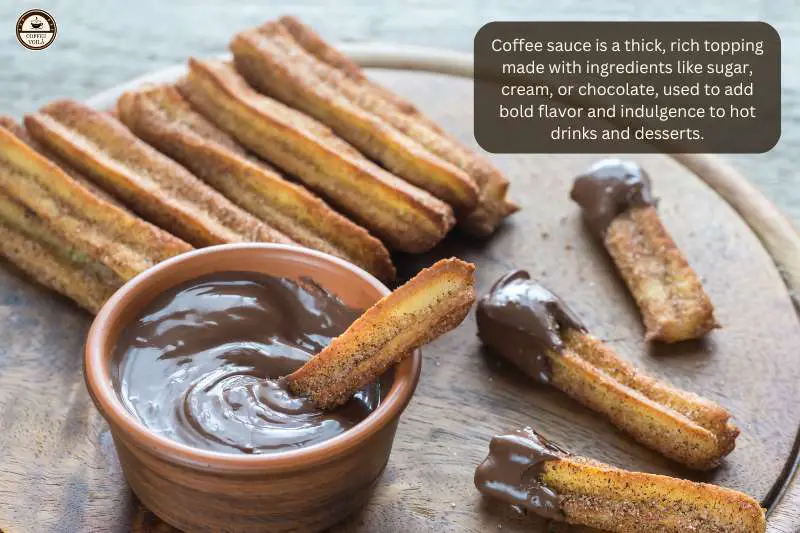
Unlike syrup, which mixes easily into both hot and cold drinks, coffee sauce shines in hot drinks and desserts. It melts beautifully into warm milk, steams, and espresso. It’s not just about sweetness, it’s about depth of flavor.
I like to think of coffee sauce more like a finishing touch or an enhancement. You drizzle it over whipped cream, swirl it into a mocha, or even layer it into a milkshake. It adds richness and body to the drink.
What Are the Common Flavors?
When it comes to flavors, the big three are chocolate, caramel, and white chocolate. You’ll see these all over the place in cafés, mochas use chocolate sauce, white mochas use white chocolate sauce, and caramel sauce is the star of many drizzle-topped drinks.
Some brands even have seasonal ones like pumpkin spice or peppermint bark.
Where Is It Commonly Used?
Coffee sauce is most commonly used for drizzling, swirling, or topping. Think hot lattes, cappuccinos, mochas, and frappuccinos with whipped cream and that pretty drizzle on top.
It also works great in desserts like being spooned over ice cream, layered into brownies, or used as a plate drizzle for dessert plating.
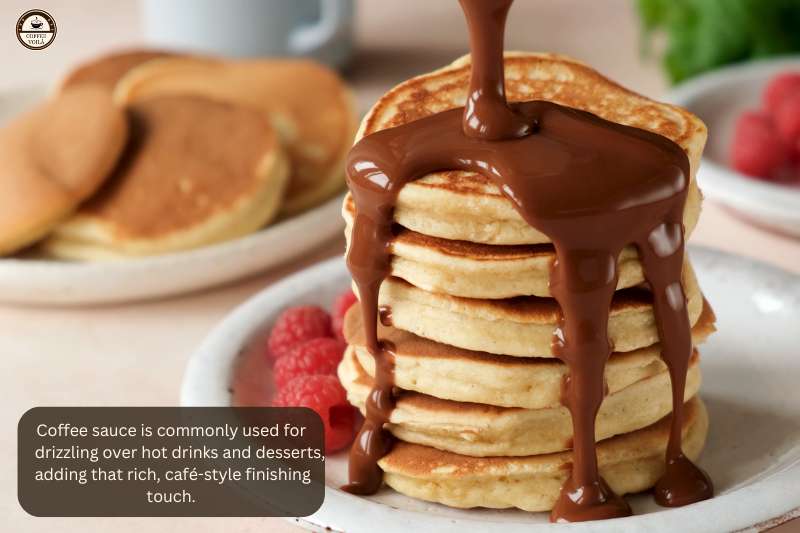
I’ve even swirled mocha sauce into banana bread batter before baking. It didn’t last more than a day in the kitchen.
So if you’re looking to add that café-style richness or take your dessert game up a notch, coffee sauce is where it’s at.
How to Tell Them Apart in the Store?
Here’s what you should look for: packaging is your first clue.
Usually, coffee syrups come in tall bottles with a pump top or narrow pour spout. They’re designed for easy pouring and blending, especially into cold drinks.
Meanwhile, sauces often come in shorter squeeze bottles or small jars with wider openings because they’re thicker and meant to be drizzled or spooned.
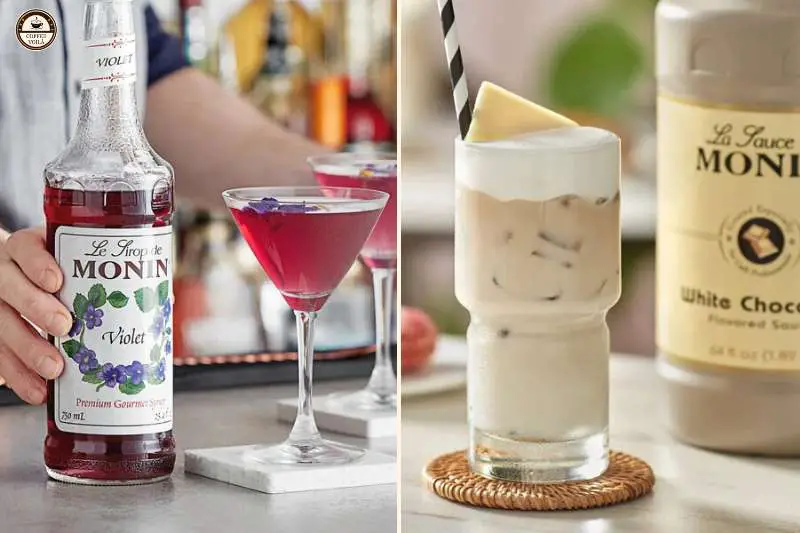
Texture Test
If you’re unsure, pour a bit out (if you’re at home or already bought it, of course). The reason is that the syrup will run quickly and feel watery. On the other hand, the sauce will move more slowly and come out in a stream or ribbon. You might even need a squeeze to get going.
Label Terminology
You want to look for phrases like “flavored syrup”, “drink syrup”, or “coffee syrup” for the thin stuff. If it says “topping”, “coffee sauce”, or “mocha drizzle”, you’re probably looking at sauce.
Shelf Placement
In most stores, syrups are typically found with the coffee and drink mixers, near creamers and sweeteners.
Meanwhile, sauces are often paired with dessert toppings, such as caramel drizzle or chocolate fudge.
Notes: Once you get used to the differences, it becomes second nature. But those first few shopping trips? You need to pay closer attention.
Can You Substitute One for the Other?
Let’s talk about when substitution works. If you’re making a hot drink like a mocha or latte, you can usually substitute coffee sauce for syrup without a problem.
The heat helps melt everything down. So even a thick chocolate sauce can blend pretty well. But in cold drinks like iced coffee or cold brew? Syrup wins. The reason is coffee sauce tends to clump or sink to the bottom unless you blend the heck out of it.
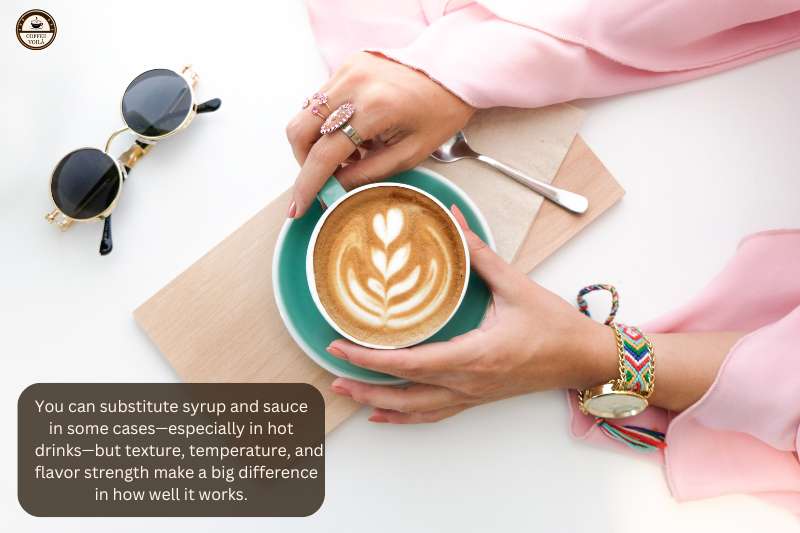
Little trick…
If you’re in a pinch, though, you can thin out a coffee sauce by warming it up and mixing in a bit of hot water or milk. Just don’t add too much liquid, or it gets weak and loses that rich flavor.
Thicker syrup
You can also thicken a simple syrup by simmering it a bit longer on the stove, but be careful not to burn it. A 2:1 sugar-to-water ratio makes a “rich” syrup that’s a little closer to sauce territory.
What about taste?
Syrups tend to be sweeter and lighter, while sauces are bolder and creamier. If you’re trying to use syrup instead of sauce in something like a drizzle topping for a frappuccino, it might slide right off or sink into the drink.
If you’re into DIY stuff, making your coffee sauce alternative is doable. For syrup, you can go basic with sugar and water or level up with flavors like cinnamon, hazelnut, or even cardamom.
Notes: So yeah, you can substitute sometimes but know the limits. Furthermore, texture and temperature matter more than you’d think. I suggest testing it once, tweaking it, and seeing if you like it.
Last Thoughts
Have you tried using both in your drinks or desserts? Do you have a favorite syrup flavor or a sauce combo that takes your coffee over the top?
I’d love to hear what you’re mixing up, so drop your favorites (or questions!) in the comments. And with that voilà!
Questions? We Have Answers.
Get answers to a list of the most Frequently Asked Questions.

